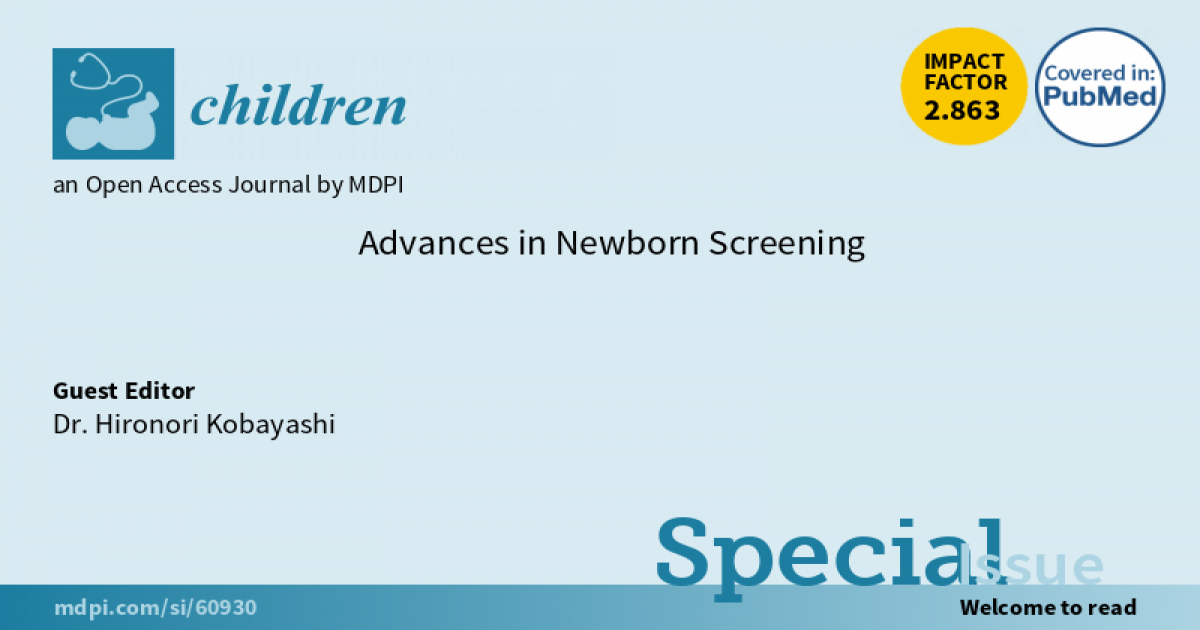Advances in Newborn Screening
A special issue of Children (ISSN 2227-9067).
Deadline for manuscript submissions: closed (1 March 2021) | Viewed by 6138

Special Issue Editor
Special Issue Information
Dear Colleagues,
More than 50 years have passed since the world's first newborn screening (NBS) program began. Initially, the NBS program was initiated for several diseases of inborn errors of metabolism, but it has gradually been expanded to include other diseases such as endocrine diseases. In the past two decades, as therapeutic options and diagnostic methods have evolved, the target diseases for NBS have become more diverse. The big change began with the expansion of NBS by MS/MS that began in the late 1990s. This method allowed us to simultaneously test for more than 20 kinds of amino acidemias, organic acidemias and fatty acid oxidation disorders. Subsequently, a method to simultaneously measure the activity of multiple enzymes in dried blood spots (DBS) was developed by utilizing the stability of lysosomal enzymes in the DBS, which allowed simultaneous screening for many lysozomal diseases such as mucopolysaccharidoses, Pompe disease, Fabry disease and Gaucher disease. The target of mass screening is expanding beyond classic metabolic disorders, and real-time PCR-based screening methods have been established for severe combined immunodeficiency (SCID) and spinal muscular atrophy (SMA).
While pilot studies have been conducted to identify new screening targets, NBS programs are starting in developing countries where NBS was not previously available, and many children are now benefiting from their NBS programs. It is very important to understand how these new NBS programs will impact the healthcare system and child health system in each country.
With great enthusiasm, we await your outstanding research. As the Guest Editors of this Special Issue, we are convinced that your work could make an excellent contribution and that your personal involvement would greatly increase its impact. Therefore, we would be thrilled if you submitted a review, research article, or case report to this Special Issue “Advances in Newborn Screening” Please feel free to submit both research articles and case reports.
Dr. Hironori Kobayashi
Guest Editor
Manuscript Submission Information
Manuscripts should be submitted online at www.mdpi.com by registering and logging in to this website. Once you are registered, click here to go to the submission form. Manuscripts can be submitted until the deadline. All submissions that pass pre-check are peer-reviewed. Accepted papers will be published continuously in the journal (as soon as accepted) and will be listed together on the special issue website. Research articles, review articles as well as short communications are invited. For planned papers, a title and short abstract (about 100 words) can be sent to the Editorial Office for announcement on this website.
Submitted manuscripts should not have been published previously, nor be under consideration for publication elsewhere (except conference proceedings papers). All manuscripts are thoroughly refereed through a single-blind peer-review process. A guide for authors and other relevant information for submission of manuscripts is available on the Instructions for Authors page. Children is an international peer-reviewed open access monthly journal published by MDPI.
Please visit the Instructions for Authors page before submitting a manuscript. The Article Processing Charge (APC) for publication in this open access journal is 2400 CHF (Swiss Francs). Submitted papers should be well formatted and use good English. Authors may use MDPI's English editing service prior to publication or during author revisions.
Keywords
- newborn screening
- lysosomal storage disease
- expanded newborn screening
- severe combined immunodeficiency
- spinal muscular atrophy
- quality assurance
- cost effectiveness






